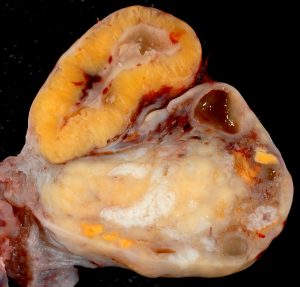The corpus luteum is a cyst derived from the ovulatory follicle, which secretes progesterone after the egg is released. It appears after ovulation and is essential for pregnancy to occur. It may sound very complicated, but it isn’t! Many people have no idea that the corpus luteum exists or what it’s for. However, for those trying to get pregnant, this is very relevant information!

To understand what the corpus luteum is, we need to start at the beginning. Let’s understand ovulation itself and the function of this important yet little-known character. It all starts when a woman menstruates. Right after menstruation, the maturation of new follicles begins so that ovulation can occur during the fertile period. In the first phase the main hormones are estrogen and follicle-stimulating hormone (FSH). They promote the development of the endometrium as well as the maturation of eggs1.
Phases of the Cycle
The cycle has three stages: follicular phase, fertile phase, and luteal phase. In a normal ovulation cycle, it is common for 10 to 20 small eggs to be stimulated. Typically, one of them develops faster and grows larger than the others. This one usually becomes the so-called dominant follicle.
After growing and maturing, this follicle reaches about 21mm in thickness and can be released by the ovary. Then, luteinizing hormone (LH) comes into play, and its peak signals egg release. At this moment, it is important to know that egg-white cervical mucus is a major sign of ovulation. Also, one of the signs that ovulation is about to happen can appear: the famous twinges on one or both sides of the lower abdomen in a woman.
If you are trying to get pregnant and want to carefully track your cycle, a tip is to use ovulation tests. They will indicate if ovulation is approaching, happening, or already ended2. This way, you’ll know when it’s the right time to try and get your positive result more quickly. The ovulation tests we recommend are from the brand Famivita.
The Corpus Luteum Can Even Confuse Doctors!
When the egg is finally released to be fertilized, the former dominant follicle now becomes the corpus luteum. The corpus luteum starts to secrete progesterone so that the endometrium remains thick. That’s how it can host a possible embryo if implantation occurs and thus sustain the pregnancy.
This stage of the cycle is called the luteal phase3. The corpus luteum is the main progesterone secretor, which is why it’s so important for it to be active. It’s common to see written on an ultrasound report: Presence of a secretory cyst in the right or left ovary.In some cases, the corpus luteum can also be mistaken for a large cyst.
This is exactly the presence of the post-ovulatory corpus luteum. Many women may think that a cyst is always a bad thing, but a temporary functional cyst can be the best sign for those trying to get pregnant. The functional cyst or corpus luteum cyst is proof that ovulation has occurred and with that, a possible pregnancy may be even closer to happening. However, the corpus luteum may also be confused with a dermoid cyst because of its shape, even by doctors.
When Pregnancy Symptoms Appear
When the egg is fertilized, it begins dividing and attaches to the endometrium. This process is called implantation. After this event, the corpus luteum starts secreting even more progesterone and causes the appearance of pregnancy symptoms. For some women, this also results in the well-known twinges and discomfort, breast pain, and other common symptoms. However, if fertilization doesn’t happen, or if it does but there’s no implantation, the corpus luteum starts to break down and disappears at the same time as the endometrium during the menstrual bleeding. Then a new cycle begins.
Women trying to conceive are more sensitive to the signs of a possible pregnancy. Because of this, the pains caused by corpus luteum activity can be noticed more easily and the symptoms become more obvious, resembling those of pregnancy.
But the symptoms may only reflect ovulation and the increase of progesterone produced by the corpus luteum. We should remember that timing is essential in evaluating these symptoms. If a menstrual delay happens and symptoms continue, it’s quite possible that ovulation could have resulted in a pregnancy. Just be patient and wait for the right time to take a test. If, due to anxiety, you can’t wait until a missed period, choose more sensitive pregnancy tests, like those from the Famivita brand. With 10 mUi sensitivity, they can detect HCG levels up to 5 days before your expected period. Find Famivita pregnancy tests here.
Readers’ Questions:
How is the corpus luteum formed?
Every month, the corpus luteum forms from the dominant follicle after ovulation. It continues producing hormones and, when pregnancy does not occur, lasts about 14 days before it starts to break down.
How do you identify the corpus luteum?
To identify the corpus luteum you need an ultrasound, where you can see its presence through the images.
Where is the corpus luteum located during pregnancy?
If pregnancy actually occurs, the corpus luteum remains in the ovary, grows, and becomes much larger than the follicle it came from. The larger it is, the better for the pregnancy, since it secretes progesterone to maintain the endometrium in the early stages of pregnancy.
See also: Pregnancy Symptoms – What Are They and When to Take Them Into Account? and Pregnancy calculator












